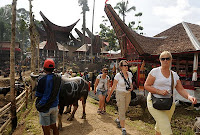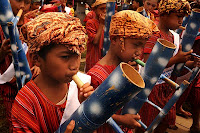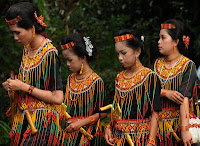Dieng plateau is considered to be a place that has mystical overtones and considered sacred. Dieng itself comes from the Javanese Word dihyang which means the place of the ancient spirits of the ancestors.
Dieng plateau has a natural beauty in the wrap of cool air and warmed by the hospitality of its people. However, there are unique in the Dieng plateau that is the phenomenon of the child or the child's Hobo dreadlocks.
The phenomenon of child dreads this happens in a number of villages in the Highland Dieng, Central Java. The children of the original 40-day-old Dieng to 6 years have dreads are natural and not created.
The child was originally stricken with fever dreadlocks with very high body temperature accompanied delirious bedtime ("ngromet" = speak for themselves). These symptoms are not treatable until normal by itself but the hair children will turn into dreadlocks.
"If cut the dreads prior but the child's not request than result in the child sick and even re-growing hair dreadlocks."
Dreads children there are several strands of scroll by in the back, covered with fine hairs on the outside. There is also a clot of thick hair like dreadlocks and dull that were never washed.
Children are also sometimes acting up I don't like her age because it is often aloof. Local people believe that the aforementioned is the middle child of the lone bercengkerama with gaibnya. They dare not violate abstinence-abstinence comes to children this myth, such as cutting the snot dreads before the child asks for a cut. If violated would result in the child then pain and any hair back dreadlocks.
Dreads Dieng as surrogate child is believed to be the ruler of the supernatural and could be cut after the new demand of the child concerned. There was also a request from the child to be met and this desire was not able to include other Parties intervened by his parents. Such requests must be fulfilled, there can be less or more. Sometimes the child can ask for anything, not to mention the implementation of cross-cutting ritual snot or the dreads requires considerable expenses. Sometimes if the request is not granted then the child the child would return sick and gimbalnya hair grows back.
Before cutting hair ceremony will be performed ritual prayer, in some places that the ceremony can go smoothly. These places are the Temple complex of Candi Dwarawati, Arjuna, Sendang Maerokoco, Gatot Kaca, Telaga Temple Hall, Candi Bima Kambang, Sikidang crater, the Hermitage complex Mandalasari (cave in the quietness of the color), Time, and place of burial Pepek Dieng. The evening ceremony will be resumed, i.e. leaching Jamasan Heirloom heritage brought the kids the bride dreads for hair cut.
The next day a new bride to shearing is done. Journey started from the House of elders and indigenous stakeholders stopped near Sendang Maerokoco or Sendang Sedayu. During the tour the village children dreads it escorted the elders, the socialite, paguyuban groups, as well as traditional art community.
After the bride later performed at wells for bathing children dreadlocks Sendang Sedayu or Sendang Maerokoco located in Darmasala Temple complex North of Arjuna. Upon entering the well of him that Sedayu kids dreadlocks are protected and long fabric Robyong umbrella around Sendang Maerokoco. Once completed, the children were escorted to dreadlocks shearing.
The ceremony will be presented in the form of shearing head chicken offerings, tempe gembus, etawa goat, marmot, and other offerings that are derived from the results of the earth around the Dieng plateau.
Prior to shearing, traditional art will entertain kids dreadlocks and the community. When it came time cutting hair then one-by one son called dreadlocks. Among them there is a feeling of fear and there is also a cheerful ramainya visitors. in the mood The child's parents believe that this ritual of dreadlocks can free their child from any diseases and bring sustenance.
The process of cutting a child's hair is dreadlocks will last about 30 minutes at the front of the Temple of Arjuna. Shearing dreads done community leaders and stakeholders of custom guide accompanied.
The next ceremony will take place or object that ceded the requested child dreads before. The next ceremony will be washed away for scrap to dreads flowing into Lake Color Serayu River and discharging into the southern coast in the Indian Ocean.
"Pelarungan" (drowning in water) haircutsof dreadlocks to the River symbolizes the return "bala" (misfortune) who brought the child to the gods. There is a belief that children's apartment with his dreadlocks and hair cuts that jin will repel jin out of her body so that all will be lost and the sustenance of bala had come.
There are two versions about the origin of the long-haired dreadlocks child Dieng . First, the common circulating in society are the dreads are surrogate "Kyai Kolodete", i.e. progenitor of society first opened Dieng village. "Kyai Kolodete" swearing isn't going to cut her hair and will not take a shower before the opening of the village became prosperous. Later his descendants will have the same hair characteristics such as himself and that sign will bring prosperity for his village. The second version is that dreads "Kanjeng Ratu Kidul" surrogate on the South coast. This belief is believed to have been a part of society still embraced trust "Kejawen".
The ceremony haircut the child dreads are included in annual event "Dieng Culture Festival" in July. The event featured cross dreads, festival art and culture, typical products fairs Dieng. You'll see kids dreadlocks with dikirab horse-drawn carriage accompanied by the man dressed in traditional Javanese dance during followed around the village. The dance is also called game angklung and harmonization of percussion and Javanese gamelan and Javanese nuance in Islam. Featured attractions such as various art, lengger, "warok tek-tek", rampakyaksa, lion dance, and a variety of other arts.
Dieng plateau has a natural beauty in the wrap of cool air and warmed by the hospitality of its people. However, there are unique in the Dieng plateau that is the phenomenon of the child or the child's Hobo dreadlocks.
The phenomenon of child dreads this happens in a number of villages in the Highland Dieng, Central Java. The children of the original 40-day-old Dieng to 6 years have dreads are natural and not created.
The child was originally stricken with fever dreadlocks with very high body temperature accompanied delirious bedtime ("ngromet" = speak for themselves). These symptoms are not treatable until normal by itself but the hair children will turn into dreadlocks.
"If cut the dreads prior but the child's not request than result in the child sick and even re-growing hair dreadlocks."
Dreads children there are several strands of scroll by in the back, covered with fine hairs on the outside. There is also a clot of thick hair like dreadlocks and dull that were never washed.
Children are also sometimes acting up I don't like her age because it is often aloof. Local people believe that the aforementioned is the middle child of the lone bercengkerama with gaibnya. They dare not violate abstinence-abstinence comes to children this myth, such as cutting the snot dreads before the child asks for a cut. If violated would result in the child then pain and any hair back dreadlocks.
Dreads Dieng as surrogate child is believed to be the ruler of the supernatural and could be cut after the new demand of the child concerned. There was also a request from the child to be met and this desire was not able to include other Parties intervened by his parents. Such requests must be fulfilled, there can be less or more. Sometimes the child can ask for anything, not to mention the implementation of cross-cutting ritual snot or the dreads requires considerable expenses. Sometimes if the request is not granted then the child the child would return sick and gimbalnya hair grows back.
Before cutting hair ceremony will be performed ritual prayer, in some places that the ceremony can go smoothly. These places are the Temple complex of Candi Dwarawati, Arjuna, Sendang Maerokoco, Gatot Kaca, Telaga Temple Hall, Candi Bima Kambang, Sikidang crater, the Hermitage complex Mandalasari (cave in the quietness of the color), Time, and place of burial Pepek Dieng. The evening ceremony will be resumed, i.e. leaching Jamasan Heirloom heritage brought the kids the bride dreads for hair cut.
The next day a new bride to shearing is done. Journey started from the House of elders and indigenous stakeholders stopped near Sendang Maerokoco or Sendang Sedayu. During the tour the village children dreads it escorted the elders, the socialite, paguyuban groups, as well as traditional art community.
After the bride later performed at wells for bathing children dreadlocks Sendang Sedayu or Sendang Maerokoco located in Darmasala Temple complex North of Arjuna. Upon entering the well of him that Sedayu kids dreadlocks are protected and long fabric Robyong umbrella around Sendang Maerokoco. Once completed, the children were escorted to dreadlocks shearing.
The ceremony will be presented in the form of shearing head chicken offerings, tempe gembus, etawa goat, marmot, and other offerings that are derived from the results of the earth around the Dieng plateau.
Prior to shearing, traditional art will entertain kids dreadlocks and the community. When it came time cutting hair then one-by one son called dreadlocks. Among them there is a feeling of fear and there is also a cheerful ramainya visitors. in the mood The child's parents believe that this ritual of dreadlocks can free their child from any diseases and bring sustenance.
The process of cutting a child's hair is dreadlocks will last about 30 minutes at the front of the Temple of Arjuna. Shearing dreads done community leaders and stakeholders of custom guide accompanied.
The next ceremony will take place or object that ceded the requested child dreads before. The next ceremony will be washed away for scrap to dreads flowing into Lake Color Serayu River and discharging into the southern coast in the Indian Ocean.
"Pelarungan" (drowning in water) haircutsof dreadlocks to the River symbolizes the return "bala" (misfortune) who brought the child to the gods. There is a belief that children's apartment with his dreadlocks and hair cuts that jin will repel jin out of her body so that all will be lost and the sustenance of bala had come.
There are two versions about the origin of the long-haired dreadlocks child Dieng . First, the common circulating in society are the dreads are surrogate "Kyai Kolodete", i.e. progenitor of society first opened Dieng village. "Kyai Kolodete" swearing isn't going to cut her hair and will not take a shower before the opening of the village became prosperous. Later his descendants will have the same hair characteristics such as himself and that sign will bring prosperity for his village. The second version is that dreads "Kanjeng Ratu Kidul" surrogate on the South coast. This belief is believed to have been a part of society still embraced trust "Kejawen".
The ceremony haircut the child dreads are included in annual event "Dieng Culture Festival" in July. The event featured cross dreads, festival art and culture, typical products fairs Dieng. You'll see kids dreadlocks with dikirab horse-drawn carriage accompanied by the man dressed in traditional Javanese dance during followed around the village. The dance is also called game angklung and harmonization of percussion and Javanese gamelan and Javanese nuance in Islam. Featured attractions such as various art, lengger, "warok tek-tek", rampakyaksa, lion dance, and a variety of other arts.


















